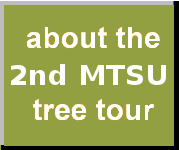
|

|

|

|
An individual instance of Tilia americana (American basswood)
Permanent unique identifier for this particular organism:
http://bioimages.vanderbilt.edu/mtsu/11
Notes:
Description
General: Basswood family (Tiliaceae). Native, large deciduous trees, the bark gray and furrowed with flat ridges. Leaves deciduous, alternate, more or less unevenly heart-shaped or the base often nearly truncate, petiolate, the blades 5-12.5 cm wide, thick and slightly leathery, with shallowly toothed margins, glabrous on both sides or with some pubescence on the lower surface. Flowers yellowish-white, 10-14 mm broad, fragrant and nectar-bearing, in drooping, 6-20-flowered clusters hanging on a stalk that diverges from near the center of an oblong, leaflike and strongly veined bract 5-10 cm long. Fruits mostly globose, 8-10 mm broad, hard and dry, indehiscent. The common name is from bastwood, referring to use of the inner bark, the bast, for rope, baskets, etc.
Uses
Ethnobotanic: Native Americans and settlers used the fibrous inner bark ("bast") as a source of fiber for rope, mats, fish nets, and baskets. Basswood is still valued for its soft, light, easily worked wood, especially for turned items and hand carving. It once was the material of choice for prosthetic limbs, but these are now made from synthetics. Other uses have included boxes, toys, woodenware, drawing boards, veneer, venetian blinds, excelsior, and pulp. Native Americans used fresh basswood sap, which contains moderate amounts of sugar, as a watery drink or boiled it into syrup. They also ate young basswood leaves and used the cambium for soups and breads. Various medicinal uses were made of leaf and bark extracts, and Iroquois used freshly cut bark as an emergency bandage for wounds.
Wildlife: Basswood is good browse and buds are important for birds and deer in winter. Fruits are eaten by birds and small mammals. The wood decays easily and produces many cavities (especially in trees past 120 years of age), which are used by cavity-nesting animals (wood ducks, pileated woodpeckers, other birds, and small mammals). Basswood is a prolific nectar producer and pollination by honeybees results in a choice grade of honey.
Restoration: Basswood is planted as a shade tree or ornamental. For sites of smaller size or with compacted soils, other Tilia species may be more suitable. Basswood is said to be a soil-enriching species, bringing calcium and magnesium up from deep in the soil profile and depositing it in leaf litter on the surface.
Distribution
Tilia americana is native to the Northern Deciduous and Great Lakes - St. Lawrence forest regions of North America. It also extends into grassland areas along river courses in Manitoba and the mid-western United States, where it forms a component of riverine gallery forests. In Canada, it is found from western New Brunswick into southern and central Québec and Ontario, extending as far west as north-western Ontario (along the U.S. border) and southern Manitoba. In the United States, the species occurs as far south as the mountainous regions of North Carolina, Tennessee, and northern Arkansas. The western limit for the species is south-central Manitoba and North Dakota, and along the Niobrara River in north-central Nebraska. Basswood is most common in forests with long fire-free intervals, because the thin bark and shallow roots are easily damaged by fire.
References
Nesom, G., & Anderson, M.K. (2003). Plant guide for basswood (tilia americana L.). Retrieved from http://plants.usda.gov/java/factSheet

|

|
|
Load database and switch to thumbnail view
Use this stable URL to link to this page:
http://bioimages.vanderbilt.edu/mtsu/11.htm
This particular organism is believed to have managed means of establishment.
This organismal entity has the scope: multicellular organism.
Identifications:
Tilia americana
L.
sec. Tennessee Flora 2014
common name: American basswood
family: Tiliaceae
Identified 2016-03-13 by Patrick Phoebus
Location:
Alma Mater Dr, Rutledge Hall, Rutherford County, Tennessee, US
Click on these geocoordinates to load a map showing the location: 35.8494°, -86.37°
Coordinate uncertainty about: 10 m.
Altitude: 190 m.
Location calculated as average of its images' coordinates.
Occurrences were recorded for this particular organism on the following dates:
2016-03-13
2016-04-27
The following images document this particular organism.
Click on a thumbnail to view the image and its metadata. Load database and enable navigation by taxon and organism.
| Image | View |
|
|
whole tree (or vine) - general |
|
|
whole tree (or vine) - winter |
|
|
bark - unspecified |
|
|
leaf - showing orientation on twig |